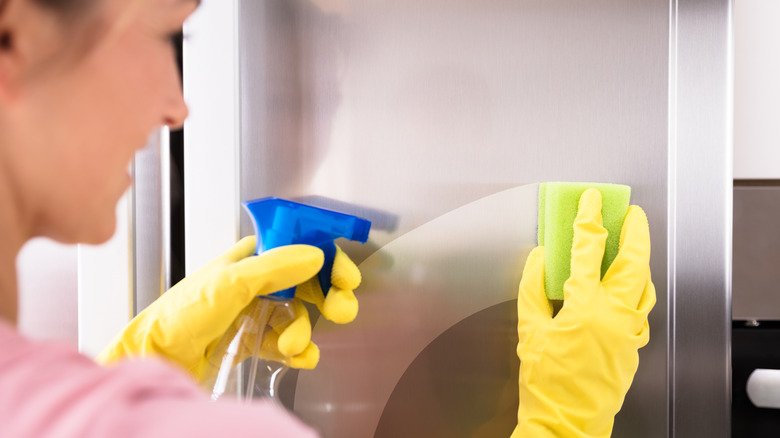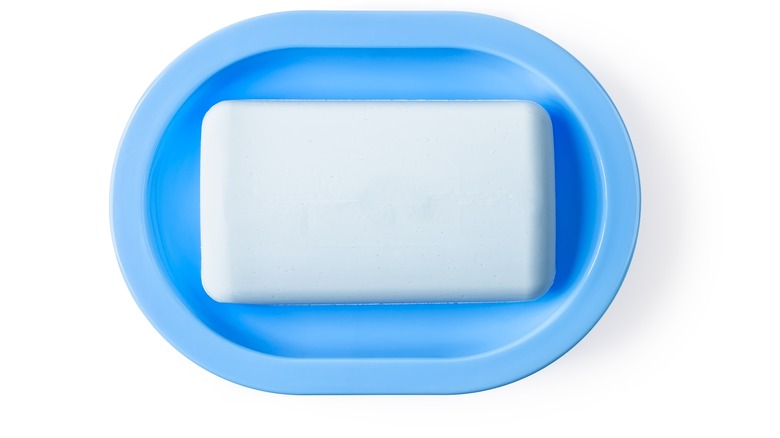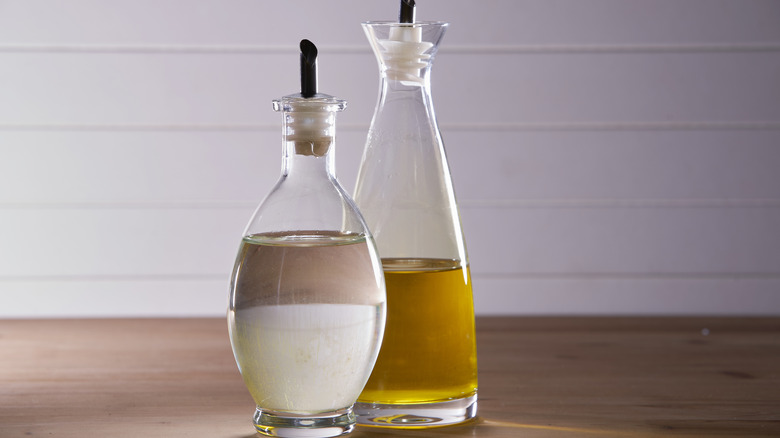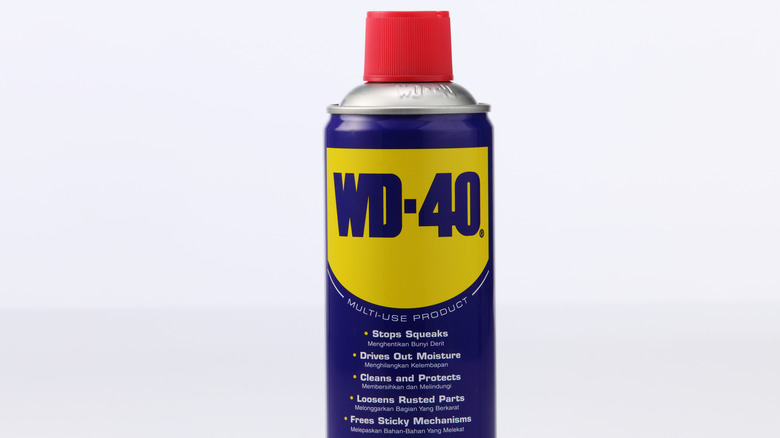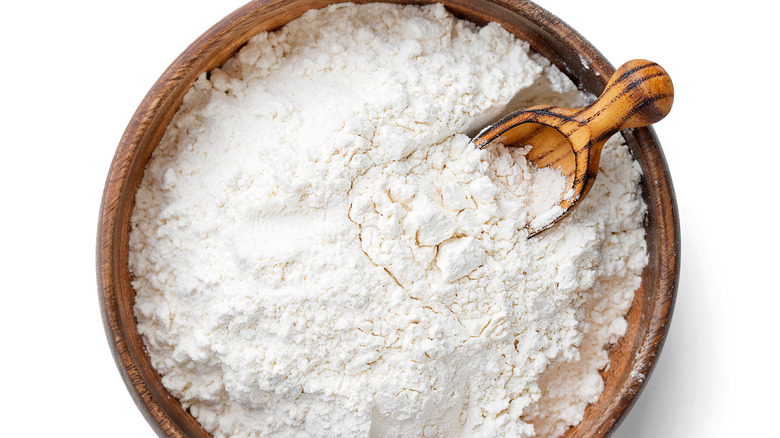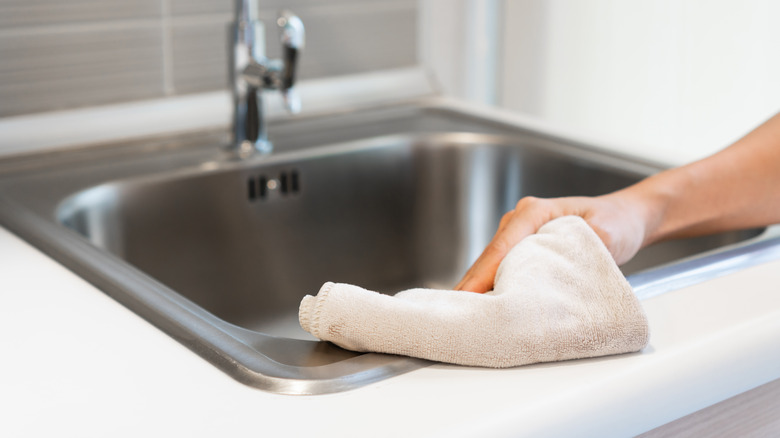Everything You Need To Know To Polish Stainless Steel Appliances
Stainless steel is best known for its resistance to rust and corrosion and ability to handle all sorts of chemicals, which makes it a popular choice for bathrooms and kitchens. And with the rise of sleek, professional-looking cooking spaces, stainless steel is often incorporated into larger fixtures such as countertops. However, if you own stainless steel appliances, you probably know they're hardly ever stainless. This is especially true if you have children running around the house. Fingerprints and water stains tend to adorn the surfaces of dishwashers, refrigerators, and ovens — this also applies to stainless steel cookware.
While stainless steel is a rugged and reliable material, it isn't immune to the effects of aging or frequent use and tends to dull over time. Harsh chemical cleaning products, usually with hefty price tags, will vow to return them to their original beauty but fail to live up to their promise. Keeping your stainless steel appliances clean is easy, and you don't need any expensive products, says Washware Essentials. In fact, they should be avoided. More often than not, you can polish your stainless surfaces using only ingredients from your pantry.
Dish soap and baby or mineral oil
Unlike wood and some fabrics, steel has a grain. These are the faint patterns you can see on the surfaces of your appliances, and an entire sheet of steel will have the same directional grain. But appliances tend to have other steel pieces attached, like knobs and handles, so keep in mind that these additional pieces may have different grain patterns. You won't ruin your appliance if you don't clean in the direction of the grain, agrees Clean Team USA. For the best shine, though, it's advised to do it anyway. Grab your cleaning supplies; use two cloths, preferably ones that are 100% cotton, because they leave almost no residual lint behind.
Next, pick up the stars of this show –– plain dish soap and baby or mineral oil. Dish soap is excellent at cleaning grime from stainless steel, explains The Maids; it washes off excess oils, making the polishing process more straightforward. Put a little bit on your rag and moisten with a small amount of water –– enough to dampen your cloth and no more. Wipe along the grain of your appliance, and after you clean an area, dry any water streaks with a clean, dry towel. At last, it's time to polish! Dab a couple of tiny drops of baby or mineral oil onto your cleaning cloth. Just like when you were cleaning, follow the grain of the steel, moving in either direction. Polishing the steel this way will give the best results.
White vinegar and olive oil
You can apply white vinegar to a microfiber cloth or spray it directly onto your surface. Let it sit for a moment, and then wipe it clean in the direction of the grain. Apply the vinegar as many times as needed to remove any grime, insists Grove Collaborative. Then dab a clean towel into some olive oil and polish the newly cleaned surface, still in the direction of the grain. If any residue remains, wipe it away with a clean cloth. This method works well because the vinegar removes grime, while the olive oil gives a fresh, shiny polish, the experts at Tampa Steel explain.
Pour a drop or two on a microfiber cloth — or a little more if you're working with a big surface, like a farmhouse sink or refrigerator. Then use the material to spread a thin layer of oil over the whole stainless steel surface of the appliance or fixture you're polishing. Once the entire surface has been covered in oil, use moderate pressure to buff it by making small circles with the oiled part of the cloth. Work across the whole surface until it feels smoother than when you began. This should only take a couple of minutes.
Club soda or WD-40
One of the most unorthodox ways to clean your stainless steel appliance is to apply club soda or WD-40 — yes, club soda. Spray the soda directly onto appliances and then wipe in the direction of the grain. This will not only help clean the surface of fingerprints and food residue but will also give a nice shine. Then, wipe clean with a soft, microfiber cloth.
Look in your garage or wherever you store your tools; you'll likely have a can of WD-40 lying around. Just spray some directly onto your appliance or in a rag, and then wipe away. Immediately, the surface of your apparatus will be clean and shiny. As a bonus, WD-40 also gives a layer of protection that helps to prevent pesky fingerprints from appearing later on. Don't forget to clean the inside of the doors because they also get covered with fingerprint oils and grime. Do exercise caution, though. WD40 explains that while the product will clean your stainless steel appliance, it's still petroleum-based. It should be used with care if employed on or around surfaces where food is handled.
Flour
If olive oil doesn't give the results you want, try another common pantry dweller: flour! This may surprise you, considering the flour costs have skyrocketed this year, according to Bloomberg, but it's true. Start by covering the entire stainless steel surface with a thin layer of flour without any clumps. For reference, it takes around ¼ cup of flour to completely cover a regular kitchen sink. Using this as a gauge, adjust your measurement accordingly. Once you've lightly coated the entire surface, repeat the buffing process, but this time with a dry cloth. You can also take a clean part of the flour sack and dry the surface.
Then, take a piece of wax paper and rub the waxy side over the surface of your appliance. The wax paper stops smudges and fingerprints for a little while and helps remove stains without leaving any streaks behind, says Reynolds. When you're done buffing, wipe away the excess flour. Your stainless steel should now be in great shape, but if it's still dull, or if you notice scratches that need smoothing out, you may need to try more options. When you finally achieve the gorgeous surface of your dreams, look into your hard work and give your reflection a thumbs-up.
Water and a cloth
You'll be surprised at how much cleaning you can accomplish with just a lint-free cloth and warm water. This is by far the least risky option for cleaning stainless steel. Plain, warm water works well in most situations, and dry everything using a towel or cloth to prevent water spots. This is critical because minerals in water can leave deposits on stainless steel — and we all know how that goes. By following the direction of the grain, you can get impressive results. Microfiber cleaning cloths are the best to use when polishing stainless steel, according to Microfiber Wholesale, because they do an excellent job absorbing all the water while not scratching the surface.
If you want though, you can buy special polishing cloths. They're finer than regular microfiber and will give your appliances a final polish. But honestly, most smudges will likely vanish without any unique products or chemicals. Stainless steel appliances are easy to maintain and durable, but they require regular cleaning. The key to keeping steel stainless is simply proper maintenance and care. While the guaranteed method would be to use a specially designed cleaning product, this is often the most expensive. Hence why we curated this list on the best way to keep your stainless steel appliances spot-free.
